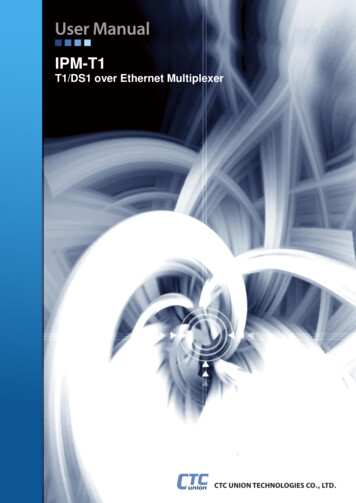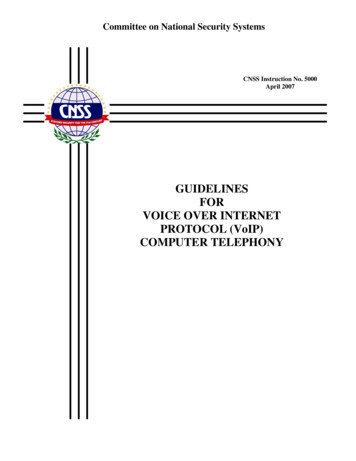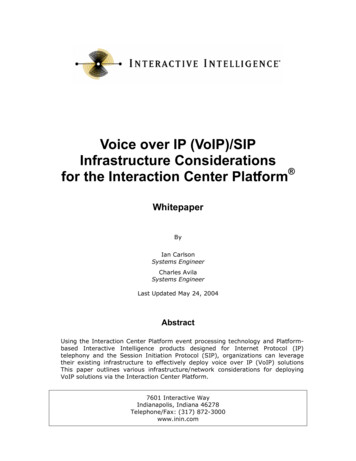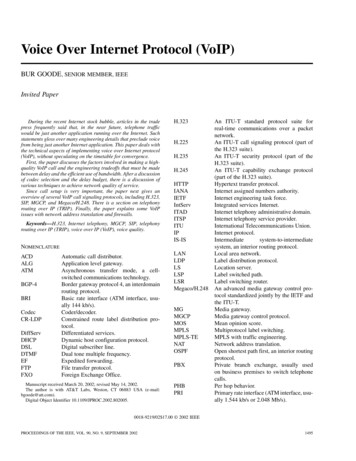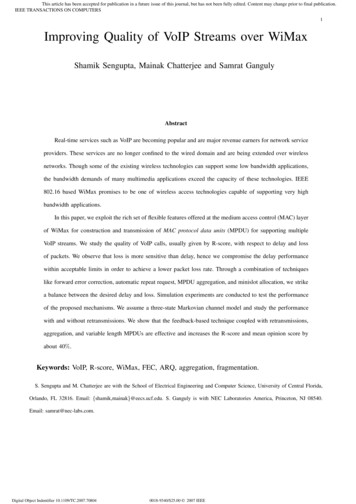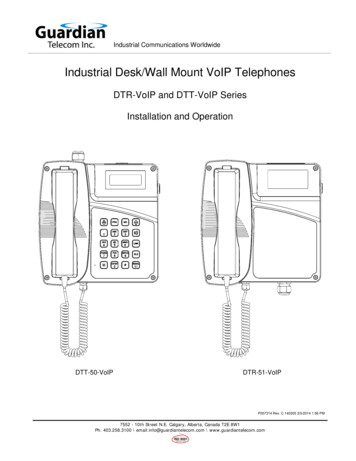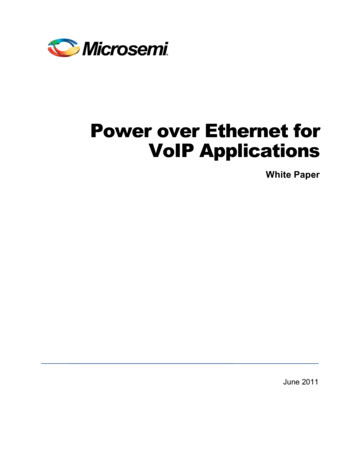
Transcription
Power over Ethernet forVoIP ApplicationsWhite PaperJune 2011
Power Over Ethernet for VoIP ApplicationsUnified CommunicationsToday’s business environment requires constant improvement in technology to support the UnifiedCommunications (UC) experience. Voice over Internet Protocol (VoIP) technology is expanding in scopeand in reach, as the business environment continues to adopt and value improvements in VoIPtechnology; better sound, more mobility, improved connectivity and data sharing, even video conferencingand recent emergence of telepresence functionality, as factors to their success. But one question alwaysremains; how will you power that?Power over Ethernet technology enables IP Telephony devices to be powered over the existing networkcabling infrastructure, thus avoiding the need for separate power and data cable infrastructure and costlyAC outlets or power bricks in user workspaces. Furthermore, it allows the removal of the electricians fromthe installation process.By connecting VoIP devices to a remote SNMP management system, organizations can experienceadditional cost savings through remote device management and scheduling.What is Power over Ethernet?Power over Ethernet (PoE) is the technology that integrates data, voice and power over standardEthernet infrastructure using Cat 5 or better cables. It is the means to supply reliable, uninterrupted powerto Internet Protocol (IP) network cameras, IP phones, WLAN Access points, Thin Clients and otherEthernet devices.Field proven Power over Ethernet technology saves the time and cost of installing separate powercabling, AC outlets and wall warts, as well as eliminating the need for a dedicated UPS for individualdevices. The power delivered over the Ethernet infrastructure is automatically activated when acompatible terminal is attached to the network and identified, and blocked to legacy devices that are notcompatible. This feature allows users to freely and safely mix legacy and PoE-compatible devices on theirnetwork. PoE technology is designed in a way that does not degrade the network data communicationperformance or decrease network reach.There are two ways to implement Power over Ethernet:2EndspanPoE enabled Ethernet Switch. Power is supplied directly from the data ports, in a layer 2device.MidspanA standalone, plug and play device, residing between an ordinary Ethernet Switch andthe end terminals, often referred to as a Power Injector or Midspan. Power is suppliedthrough a layer 1 pass-through (Figure 1).PoE Solutions
Power Over Ethernet for VoIP ApplicationsFigure 1:Architecture of Power over Ethernet in the EnterpriseKey Benefits of PoE in IP TelephonyLower Installation CostsElectrical wiring costs are greatly reduced. Those costs consist of AC wiring, electricians’ fees and ACoutlet costs. Alternatively, safe power is supplied to the IP phone or other device over the existingstandard Ethernet wires.Cost Savings through Remote SchedulingSNMP Remote Power Management tools allow scheduled up and down-time for powered devices.Reductions in power consumption result, as do better control of device utilization outside of businesshours.Increased ReliabilityDevices are connected automatically to an uninterruptible power supply (UPS) through the Ethernetcables, increasing reliability and reducing data loss. Further, a redundant power supply (RPS) offerscomplete reliability of an IP Telephony system for reductions in data loss and increased network security.Assured Safety with Advanced line Terminal DetectionLine detection enables safe installation without worry of high voltage damage to laptops, desktops andother non-power ready devices, due to a misplaced connection. A faulty camera or an access controlterminal can be detected and shut down, preventing damage to expensive switches and patch panels inthe Ethernet network. Line detection is one of the reasons why a Power over Ethernet Midspan is muchmore than an intelligent power source.VoIP Installation Using Power over EthernetIP Telephony systems are being installed today in many different environments. Most common amongthese:§ Large professional complexes, offices§ Transport terminals, airports§ Large retail stores, shopping malls, casinos§ Higher education campuses§ Healthcare facilitiesThere are differences in the requirements from the Unified Communications system for each type ofenvironment. An office installation, for example, with its structured environment and high user count willbe very different from an education or healthcare installation with more distributed structure and moreflexible environment.This paper focuses on the approach to optimize the VoIP system with Power over Ethernet. Fortunately,most UC device installations share very similar infrastructure.The Ethernet lines run from the network switch, sometimes through a patch panel, out of thecommunication room and connect to the VoIP phones and other IP devices (see Figure 2 on page 4).Adding PoE enables devices to be powered over the same Cat 5 cabling infrastructure, providing themost cost-effective solution.When a Switch is already installed, the simplest means to add PoE is by adding a dedicated PoEMidspan.PoE Solutions3
Power Over Ethernet for VoIP ApplicationsFigure 2:Unified Communications SystemInstallation TipsThe following are some installation tips, when installing IP based and PoE Powered Devices (PDs):Power devices using PoE wherever possible. Midspans provide a simple convenient (plug and play) means to remotely power-down devices duringperiods of non-use and power-up again when needed. Maintaining UPS capability. This creates reliable power access to the devices and eliminates dataloss.It may be tempting to use some AC outlets that are available, hoping to save some installation costs. Thishas the following implications:§ The vacuum cleaner effect – Cleaning personnel like to unplug devices while cleaning, to use theAC outlet, as they are easy to find. This can cause data loss.§ The free long distance effect – Unsupervised service personnel may be tempted to use thisopportunity to call home, which may incur International charges.Install all PoE Midspans in communication rooms and data centers. To minimize tampering with theunits and enable central management, 6-port, 12-port and 24-port units should preferably be rackmounted. Single port and 4-port devices can be placed on top of equipment or wall mounted.Color code cables. This will assist in management and indicate that these cables are not to be touchedby maintenance personnel.4PoE Solutions
Power Over Ethernet for VoIP ApplicationsConcentrate UC devices to optimize installation costs and effectiveness. Rather than attempting toinstall the shortest cabling, try to pull network cabling to a single communication room rather thandistributing small numbers of device ports in network closets. This will enable selection and flexibility inchoosing a Midspan and a higher port density Midspan will save rack space and installation costs.Non-Standard Devices Using a SplitterThere are IP end terminals that were not originally designed to accept power from the Ethernet. Thesedevices either only accept power through their DC jack while their RJ45 input only accepts data or theyonly accept voltage levels lower than the standard’s 48 volts DC.By using a passive or active splitter the device immediately becomes PoE ready without any modificationrequired on either side.How to Select the Appropriate PoE MidspanOnce installed, the VoIP phones Ethernet cabling is pulled to the communication rooms, where theSwitches and Midspans are installed.When choosing a PoE solution, the following aspects should be considered:§ The number of devices to be connected to the Midspan – referred to as port density§ Power consumption of each device§ Future expansion plansThe port density of phones that reach a specific communication room depends on the followingparameters:§ Ethernet cable maximum length, which is 100 meters (330 feet) without a PoE extender§ Number of devices needed, per total site§ The geographic stretch of the facilityNon-IEEE802.3 compatible devices: Determine the number of non-standard devices that will needactive splitters to reduce voltage or increase amperage.Number of ports: Once the number of UC devices per communication room has been estimated, selectthe appropriate PoE Midspan.Ports DensityAppropriate PoE tRoom for Expansion: In a similar fashion to Ethernet ports, 1 to 2 spare ports should be available forfuture growth.Remote Management and Gigabit support: Determine whether you want to control the power suppliedto the phones. Identify the required communication transfer rate (10/100/1000BaseT).PoE Solutions5
Power Over Ethernet for VoIP ApplicationsConclusionThis paper serves as a guide for the optimization of an Ethernet based IP telephony UnifiedCommunications system, utilizing Power over Ethernet. Using the information provided here will assurethe installer, user, or IT manager an easier to set up and maintain PoE-based VoIP network. Installationbecomes simpler, more reliable and outright cheaper.PowerDsine PoE Solutions by Microsemi provide IT managers the simplest, safest, most cost-effectivesolution for installing the network. The advanced features of the PoE Midspans also vastly simplifyongoing maintenance of the network, enabling reliable continuous operation with minimum downtime. Thepaper discusses the means to optimize features of PoE Midspan.Advanced detection guarantees safety and interoperability with many Powered Devices.For more information on Microsemi’s PowerDsine PoE Solutions, visit www.microsemi.com/powerdsine.6PoE Solutions
Microsemi Corporation (NASDAQ: MSCC) offers the industry’s most comprehensive portfolio ofsemiconductor technology. Committed to solving the most critical system challenges,Microsemi’s products include high-performance, high-reliability analog and RF devices, mixedsignal integrated circuits, FPGAs and customizable SoCs, and complete subsystems. Microsemiserves leading system manufacturers around the world in the defense, security, aerospace,enterprise, commercial, and industrial markets. Learn more at www.microsemi.com .Microsemi Corporate Headquarters2381 Morse Avenue, Irvine, CA 92614Phone; 949.221.7100 · Fax: 949.756.0308www.microsemi.com 2011 Microsemi Corporation. All rights reserved. Microsemi and the Microsemi logo are trademarks of MicrosemiCorporation. All other trademarks and service marks are the property of their respective owners.PD2011-2-WP
VoIP Applications White Paper June 2011 . Power Over Ethernet for VoIP Applications 2 PoE Solutions Unified Communications Today’s business environment requires constant improvement in technology to support the Unified Communications (UC) experience. Voice over Internet Protocol (VoIP) technology is expanding in scope and in reach, as the .
